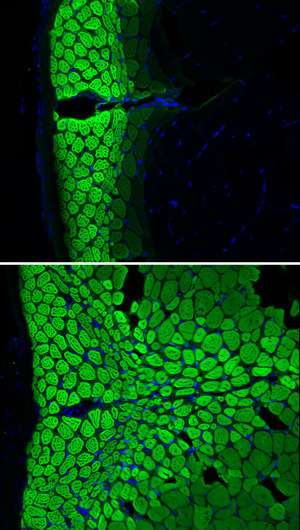The role of the sox6 gene in muscle fiber type differentiation

Muscles are made up of both 'slow-twitch' and 'fast-twitch' fibers. The body requires both fiber types to maintain a balanced skeletal muscle system, although how the two different types are determined and maintained remains uncertain. Now, A*STAR researchers have clarified the role of the sox6 gene, and its product, the transcription factor protein Sox6, in regulating fast-twitch fiber differentiation in zebrafish.
Slow-twitch fibers contract slowly and have high endurance; they help maintain strength in the back, for example. Fast-twitch fibers contract rapidly but tire quickly, releasing a burst of energy when needed. The two fiber types are genetically determined, but are also adaptive—for instance, an endurance runner can convert fast-twitch fibers to slow-twitch through training.
Previously, Philip Ingham and co-workers at the A*STAR Institute of Molecular and Cell Biology, together with scientists in the UK, identified the sox6 gene as a potential regulator of genes that determine fiber development in zebrafish. "When sox6 was misexpressed in slow-twitch fibers, they differentiated into fast-twitch fibers instead," describes Ingham. "This suggests that sox6 may normally suppress the slow-twitch program, thus promoting fast-twitch muscle differentiation. To explore this, we decided to mutate the sox6 gene in zebrafish embryos so that it could not function in any fiber."
Muscle fiber types are clearly distinguishable in zebrafish embryos, making them easy to analyze. However, making mutations in sox6 was not as simple and the researchers spent months screening fish before they found one carrying a mutation.
They were rewarded for their hard work when they found that the loss of the sox6 gene was enough to activate slow-twitch gene expression throughout all muscle fibers. Moreover, they found that when sox6 was deleted, the fast-twitch fibers began shifting their physiology to be more like slow-twitch fibers (see image). The researchers were surprised that the mutant fish survived. "Because sox6 is implicated in a number of other processes, including the specification of particular brain cells, we thought the mutation would be lethal," explains Ingham. "However, some mutant fish did survive to adulthood, albeit with significant curvature of the spine."
In a second unexpected outcome, the team discovered that the Sox6 protein only suppresses the expression of a subset of slow-twitch specific genes. "We expected that loss of Sox6 would completely disrupt fast-twitch fiber development," says Ingham. "The fact that slow-twitch genes did not completely take over means there must be other factors acting in parallel with Sox6 to suppress slow-twitch expression. We hope to identify these in future."
More information: "The role of Sox6 in zebrafish muscle fiber type specification." Skeletal Muscle 5, 2 (2015). dx.doi.org/10.1186/s13395-014-0026-2

















